Why You Shouldn’t Crack Your Neck
Sometimes when people learn that I’m a Chiropractor, they prove how they will never need one by contorting their bodies in all sorts of ways in order to pop every joint on their body. They’ll use their hands, a chair, anything they can to squeeze out that last audible release. I’m always a little taken aback by this. I never know if they’re challenging me to some sort of bone-crunching dance-off or if they’re challenging me to find some leftover restricted joint within them to adjust. Now I know this isn’t the same thing that I do to patients, but rarely do I take on the challenge of educating and informing a person who does this bone rattling dance to a complete stranger. That’s a kind of crazy best left alone. If this were a patient, I would tell him that he may be doing more harm than good in his spine. And that is just what I’m blogging about today to tell you. You can pop your knuckles, you can pop your knee, but don’t go wrenching your neck. Here’s why.
When I tell people they shouldn’t crack their neck, they pop their knuckles and say, “it’s the same thing.” It may feel the same, but no – it’s not. Let’s compare your neck to your knuckle.
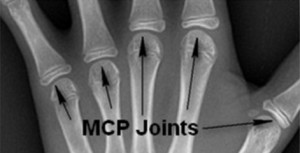 A knuckle (metacarpal-phalangeal) joint is pretty simple. You’ve got two bones coming together at one location. The joint allows for multiple motions (up, down, side, round, diagonal) all from the same point of contact. There isn’t much around the joint and it is pretty isolated.
A knuckle (metacarpal-phalangeal) joint is pretty simple. You’ve got two bones coming together at one location. The joint allows for multiple motions (up, down, side, round, diagonal) all from the same point of contact. There isn’t much around the joint and it is pretty isolated.
Now take the cervical spine. The cervical spine is composed of seven vertebrae. Each vertebra contains 6-10 joints (depending on what level) that offer different types of motion. In addition, the cervical vertebrae neighbor your spinal cord, discs, nerves that supply your neck and arms, and blood vessels that supply your brain.
When you “pop” a joint, you’re stretching the capsule very quickly and letting it implode on itself. When you pop or crack your knuckles, your moving one joint into one direction. When you crack your neck, you’re moving several joints into different directions. This will be important later.
When you pop your knuckle, you’re able to take full control over the area. But when people crack their neck, there are only a couple of ways they can move it. They can only make contact with so many areas of the neck and they can only bend their hands so much. What will end up happening is you’ll just start putting your hands on the same spots and cracking the same joints in the same direction over and over again. This isn’t good.
When you abuse a joint like that, it becomes hypermobile. It moves into one direction too much. As a result, the neighboring joint become hypomobile. They move less to make up for the stability lost from the now hypermobile joint.
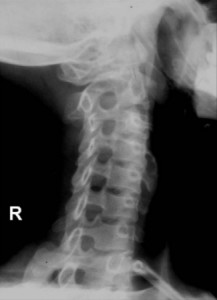 Here’s the pattern. Your neck feels a little stiff so you crack it. It feels good so you keep doing it. You’ll notice that over time, it stops feeling good and your neck becomes even stiffer after you do it. Tension headaches, upper back tightness, and jaw pain may follow.
Here’s the pattern. Your neck feels a little stiff so you crack it. It feels good so you keep doing it. You’ll notice that over time, it stops feeling good and your neck becomes even stiffer after you do it. Tension headaches, upper back tightness, and jaw pain may follow.
The joints that became hypomobile are what’s making you feel stiff. So you go to crack your neck. But you can’t reach those joints or contort your own neck in such a way that allows you to move them. You can only get the same old spots that you’ve always been able to get.
What’s the end result of this cycle? Degeneration. Just like your car, uneven wear and tear on joints causes degenerative joint disease (arthritis) which can lead to pain, cervical disc herniations, stenosis, and radiculopathy.
This is why you shouldn’t wrench on your own neck, especially when it’s feeling tight, in order to crack it. It’s best left to the neck-wrenching professionals who can assess the joints, move what needs to be moved, and spare what doesn’t.
As always, if you have any questions, comments, or would like to suggest a topic – drop a line. Like me on Facebookfor regular health tips and updates. Until next time, eat well and move often.
Photo credits:
www.wristsupportbraces.com
www.ceessentials.net
Questions about this post?
Dr. Lell would be happy to answer questions or provide more information discussed in this blog post. Contact him through our Contact Page.
There’s Not Enough D in Portland
Dr. Lell here and today I want to talk about vitamin D (hereafter plainly referred to as D). We’ll go over what you probably know, what you might not know, how you’re not getting the D you need. Especially if you live here in Portland. And why you should consider vitamin D supplementation this winter. On a side note, if you think vitamins don’t work, check out this other blog post.
Now we all know D is the bone vitamin. The sunshine vitamin. It helps your body absorb calcium and too little D can lead to things like osteoporosis and rickets. But we’re learning that the D – when maintained at higher levels in the blood – also works as an immune booster, an anti-inflammatory, and a neuro-hormone. D receptors are found on a lot of different cells in our bodies leading researchers to ask “why?” In investigating their use, they discovered these new functions. I took the time to go over the latest research and I want to highlight some of the benefits that I found.
Vitamin D prevents…
- Diabetes. Researchers found that early exposure to higher levels of vitamin D helped to prevent the onset of type 1 diabetes in children. In adults, an observational study of pre-diabetics showed that second to being black, having low levels of vitamin D was the largest predictor for the development of Type 2 Diabetes.
- Heart Disease. People with adequate levels of vitamin D in their blood were 162% less likely to suffer a major cardiac event such.
- Falling. Anyone with older family members knows that falling is an issue. And a broken hip in a senior citizen is practically a death warrant. Vitamin D reduced the chance of falling in older people by 61-72%
- Alzheimers. Certainly this is a multifactorial problem but observational studies showed that those who develop this disease have lower levels of vitamin D in their blood.
- Depression. Serotonin, the happy hormone, requires vitamin D. This is why Seasonal Depression occurs when the days get shorter and colder.
- Pain. Not only does it work as a body-wide anti-inflammatory, but a functional lack of vitamin D can cause muscle pain.
- Cancer. Different blood levels of D protects from different cancers, but an amount between 53-61 ng/ml help to prevent 50-67% of breast cancers.
That’s the good news about D. Here’s the bad news – you’re probably not getting enough D to get those benefits. The cards are stacked against us by region, weather, and diet.
Region
Those living above the 37th parallel are statistically less likely to have sufficient amounts of vitamin D in their blood. This is due to the Earth’s tilt and how the sun hits us.

Weather
Many people learned that 15 minutes of sunshine will get you all the vitamin D you need, the daily recommended value of 600 IU. However, the RDA represents the bare minimum value needed to prevent bone disease. Those 15 minutes a day won’t get your levels anywhere near what you need to experience the other benefits. On top of that, the U.V. rays needed to produce vitamin D in the skin don’t penetrate clouds (luckily we don’t have many of those in Portland). The graphs below show how likely you are to be producing vitamin D from your routine sun exposure. The warmer the color, the more likely you’re producing your own D from the sun.

Diet
I picked up a random person off the street and tested their blood, they’d likely have about 12-20 units, which is considered insufficient but it’s enough to keep you from getting rickets. To maintain this insufficient amount, you would need about 1,000 International Units a day. The typical mult has about 400. We’ve already established that if you’re living in a certain region during a winter month, you’re likely not getting enough from the sun. This leaves the main source from your diet. But the vitamin D found in animals and plants, D2, is not as potent or as effective the D we make from sunshine, D3.
Filling The Gap
So how do you fill the gaps with the D you need? Supplementation is, in my opinion, the best option (unless there’s a medical reason that a person shouldn’t take vitamin D). Now I mentioned before that this is a fat soluble vitamin – you can accumulate too much in your blood blood but it would take a whole lot of D to do this. If you have reservations about supplementation, consult a healthcare professional and maybe get your levels checked. There are many walk-in labs here in Portland that can make this kind of labwork affordable for the under-insured.
As always, if you have any questions, comments, or would like to suggest a topic – drop a line. Like me on Facebook for regular health tips and updates. Until next time, eat well and move often.
Questions about this post?
Dr. Lell would be happy to answer questions or provide more information discussed in this blog post. Contact him through our Contact Page.
Why I Prescribe Movement as Medicine
One thing that sets me apart from other Chiropractors is my emphasis on movement. If muscle pain and injury is the disease, movement is the medicine.
Why does movement matter? Do you have a rib that keeps coming out? An S.I. joint that always gets stuck? It’s easily fixed by a Chiropractic adjustment, some massage, or maybe some accupuncture but the pain and problem keeps coming back. Why? Does that rib prefer to be out? Does the S.I. joint one day wake up and decide that it doesn’t want to move? No! Our body responds to the movement patterns the we use and live our lives with.
Think of your body as a computer. Your muscles, joints, and limbs are the hardware and our brain and how we move is the software. If you’re moving improperly, unbalanced demands are being placed on certain muscles and joints in your body. This doesn’t stop you from living. Your body is strong – it adapts! It runs a new movement program. If you damage your ankle, you limp. Your brain (the software) knows that walking on that ankle will hurt. So it runs a new movement program on your body (the hardware) and we call it a limp. It isn’t good on the other joints that are now overcompensating, but it allows you to get from point A to point B.
Not all changes in movement patterns are as obvious as an injury. Most are more insidious. Always lounging on the couch in the exact same way, that wallet in your back pocket, that heavy and poorly worn back-pack, that big purse that’s always on your left shoulder – all of these unbalanced demands on your body cause your brain to change the way you move. You undergo a state of altered motor control.
Now this is no big deal in isolation. Everyone has their own unique way of moving. A story of what we’ve demanded from our bodies. But this altered motor control can lead to injury and then pain in certain areas. This is why sleeping in a new bed can through your back out, bending over to tie your shoe can cause a disc to blow, and why sneezing can pop a rib out. When you take a system that is running inefficiently and then throw increased demands (a new sport or exercise routine), injury (sprained ankle) or age (I hear that getting old sucks at least 10 times a day) at it, your body will speak out – usually through pain.
So you’re going about your day and you sneeze. There’s a constant sharp pain in your back and it hurts to take deep breaths. The rib joint is locked up and the muscles around it are spasming. You get the rib adjusted, get some acupuncture on the muscle, and you feel amazing. But then it happens again later and the cycle repeats. Why? Was the human body meant to hurt by a sneeze? No.
The rib joint and the muscles caused the pain and fixing them made you feel better. But then you went back out there in the world, moved in such a way that places extra demand on that area, and the sudden jolt of a sneeze caused pain again. The way you move – your software – wasn’t addressed. Only the hardware was looked at.
When you go into the chiropractor’s, physical therapist’s, or acupuncturist’s office, they make sure that whatever area is bothering you is made perfect again at that moment in time. But when you leave those doors, you resume the same movement habits that brought you into the office to begin with.
No one likes pain and of course I use all the regular tools at my disposal to get a person out of pain and discomfort. But that’s just treating the symptom. Re-training their movement patterns with specific exercises and stretches is the long term solution that fixes the problem. And this is why I use movement as medicine.
Questions about this post?
Dr. Lell would be happy to answer questions or provide more information discussed in this blog post. Contact him through our Contact Page.
Wellness is a Piece of Pizza
Wellness has been a buzzword for the past few years. Wellness is everywhere. Your local pharmacy has a wellness point program. Your child’s school has a wellness coordinator. You’re starting to do – and buy – things for the sake of your wellness and health. But with the promotion of “wellness” comes the marketing of wellness and just like the ideas of beauty and success, wellness has been idealized with imagery that many find it hard to live up to. The image of wellness is now more appealing to many than actually being well.
What is wellness? It’s defined as the condition of being in good health. I’ve often said that health is the destination and wellness is the path. Wellness is the pursuit of health. Remember that.
What does wellness look like? That’s a hard mental picture to paint. Luckily, there are plenty of T.V. commercials that have given me a preconceived notion of the idea. When I picture what wellness has become, or at least how it’s portrayed, I see a young, fit, and woman (or man) with an organic granola bar in one hand, a bottle of deionized water in the other, and LuLuLemon everywhere else. She (or he) is seamlessly balancing life while taking the dog on a sunrise jog or running on the treadmill while taking a business call through some headphones. The fitbit says enough calories have been burned and now our image of wellness can sit down to a much deserved apple slice. That’s it. That’s what I’ve been programmed to see. And anything less than this idea of perfection is…unwellness.
That ideal is impossible to live up to; wellness has become black and white. You’re either on the treadmill all day hooked up to a kale-juice IV or you’re living in a blooper reel for a KFC commercial. But nothing could be farther from the truth!
Wellness is the pursuit of health. it’s a journey made of daily decisions and just like any other journey, there are going to be some missed turns and setbacks but it will all be okay so long as you have a sense of direction and an eye for the bigger picture. Wellness is making small decisions that make this moment in time a little more healthy. Getting fruit juice instead of a soda? That’s wellness. Getting water instead of fruit juice? That’s wellness too. You can have that pizza for lunch if you balance it out with a walk this evening or a light dinner. It’s about balance.
Those who follow me on my blog and my facebook know that health is just being balanced. From your life (work/play/personal) to your cellular chemistry. If one biochemical process becomes unbalanced in your body, there are a group of downstream consequences that we call symptoms. If the body can’t correct the imbalance, then we often call it a disease and give it a name. If health is state of being balanced, then consider wellness the act of balancing yourself out. The pictures that you see on the TV – those people aren’t the result of balance; that isn’t wellness. Blotting your pizza with a towel before you eat it…now that’s wellness.
You can start being well today and it doesn’t take any special brand or shake or clothes. Just take one small change. Maybe park a little farther away from the door today. Maybe have just one more sip of water. Tomorrow, maybe park a little farther and sip a little more. Want that cake? Have it! But maybe go for a walk later or skip your daily soda. Small things add up. Start today!
Questions about this post?
Dr. Lell would be happy to answer questions or provide more information discussed in this blog post. Contact him through our Contact Page.
Top 5 Stretches to Improve Your Mobility
Hey guys, Dr. Lell here. Do you ever feel like your spine is just one solid wooden block? It’s that stiffness that greets you in the morning and says goodnight at the end of a long day. I’ll have patients that come in complaining of it. They’re right to come and get it checked out. Constant stiffness can often turn into headaches, shoulder pain, jaw pain, hip pain, and low back pain. Sometimes it can be caused by something more serious than the old mattress. The adjustment always limbers them up but that feeling of tightness and stiffness has an annoying way of coming back. So before they leave, I always show them my favorite whole body stretch routine. I like that it keeps their muscles and joints limber and healthy. They like that it keeps them out of my office and that they’re able to take charge of their own health.
So here it is. My top 5 stretches for a healthy spine (and for fewer visits to the Chiropractor)
1 – The Cat/Camel
This is great for targeting the low back. On all fours, place your fists under your shoulders and your knees under your hips. Lift your head up while you put a dip in your low back as if you’re moving your belly button towards the floor. Then bring your chin to your chest as you put an arc or hump in your back like an angry cat.
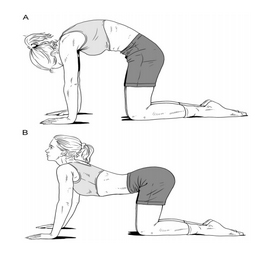
2 – The Sphinx
This is great for targeting the middle back and base of the neck. It’s the same as the Cat/Camel but your fists are very close to your knees. The motion in the low back is now emphasized in the mid and upper back.
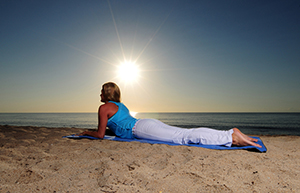
3 – Open Book
This is a good one for that hard to isolate transition area between your mid and lower back as well as your chest and shoulders.. Get on the floor on your side. Make sure there’s something supporting you head. Have you knees and hips bent to 90 degrees and stretch your arms straight out in front of you, one on top of the other, with your finger tips touching. Slide your top hand farther than your bottom hand and then roll the upper body over. The arms are supposed to look like a book opening. Let your head follow but don’t let your hips, legs, or knees move. Be sure to do the other side.

4 – Brugger’s
This is a great one for the neck and upper back and a must-do for the desk-workers and headache sufferers. Sitting or standing, make sure you have good posture. Pick up your head and look straight. Draw your chin straight back (not up or down, your eyes shouldn’t change their degree to the horizon) and try to touch your shoulder blades together. Hold the squeeze. You’re doing it right if you get a double chin, talk funny, and your chest opens up.
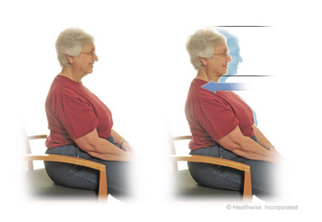
5 – The frog leg
A great one for tight hips and the low back. Start on all fours, rotate the hips out so that the bottoms of your heels touch and the insides of your ankles touch the floor. Keep those locked. Try to get your pelvis and chest flat on the floor. The insides of your knees should be touching the floor as you get closer to the ground.

And there you have it. These five stretches will keep away most back pains, hip pains, neck pains, and headaches. Remember, most biomechanical conditions not resulting from trauma are due to the way you move (or don’t move). So move well and often!
As always if you have any questions, comments, or want to see a blog about something specific – just drop a line! Like me on Facebook, Michael Lell, DC or Instagram, LellDC, for regular updates on blogs and great tips for good health.
Picture Credits
Book Open – golftodaynw.com
Cat Camel – exercisesforsciaticapuhnesh.blogspot.com
Brugger – avitahealth.ca
Frog – dancingwithlisaandsilke.wordpress.com
Why Carpal Tunnel Surgery Fails
Hey guys, Dr. Lell here. Are you or someone you know considering carpal tunnel surgery? I’m sure everyone knows someone with carpal tunnel syndrome (CTS). It’s estimated that about 15% of the general population has some of the symptoms while in some high-risk professions, like clerical workers, the percentage can jump to 81%. Many people consider surgery to be their only option and for some, this is true. Ignoring those gradually increasing symptoms to the point where the pain is unbearable and you’ve got tremendous functional deficits could make surgery a very appropriate option. But consider some facts. Carpal Tunnel surgery only helps about 71% of people. Complete restoration (being “all better”) occurs in less than 60%. The surgery could leave you with permanent weakness and there’s about a 50% chance you’ll need it again in 6 years. Given the cost (the range is around $5-10,000), invasiveness of the procedure,the down-time to recover, and the limited long term success – I always encourage people considering surgery to consider some alternatives. But first, let’s talk about why this surgery isn’t all it’s cracked up to be.
Why does the surgery have such a poor track record? For starters, many people consider it to be a condition of the wrist – but it’s not. It’s a condition of the arm. The nerves that feed your hand come from the neck and they travel down your arm through your chest, shoulder, and all the muscles of the upper extremity. There are several points along this path where the nerve can get pinched. When a nerve gets pinched, its local circulation decreases meaning it doesn’t work as well. When the same nerve gets pinched in multiple sites, the effects combine to be worse than at any one site. Think of these areas where the nerve gets pinched like a river and a dam. If you dam a river, the pants at the end of the river will go dry before the plants at the dam. Now think of a river with several dams. Your hand is at the end of the river and your wrist is the last dam. That’s why carpal tunnel surgery has such limited success – because it doesn’t treat the entire condition.
Cervical radiculopathy, thoracic outlet syndrome, pronator teres syndrome, impingement syndrome, and carpal tunnel syndrome – these are all the same thing in different parts of the neck, shoulder, and arm. But when you look at the human body through a microscope – only focusing on the wrist – you lose the forest for the trees.
Everything described above is the biomechanical aspect of the condition. There may also be an inflammatory aspect that is often overlooked before a patient is rushed under the knife. The carpal tunnel is just that – a small tunnel where everything fits just right. The majority of the tunnel is made of bones and the roof is made of a fibrous sheath called a retinaculum. A local or systemic inflammatory process can cause swelling inside the tunnel thus squeezing the delicate nerves that are inside. This is, in effect, just another “pinch” but the underlying cause is different than the pinches described above.
When it comes to long developing conditions, there is no such thing as a shoulder problem, an elbow problem, or a wrist problem. It’s an arm problem. Treating just one piece rarely offers long-standing benefits – especially in the case of carpal tunnel syndrome.
In my next blog, I’ll go over some good alternatives to surgery. Treatments that I and my patients have had good success with and treatments that others have been trying. If you’d like to stay updated and in the loop, subscribe to my feed! As always, your questions, comments, and arguments are welcome. Until then, stay well.